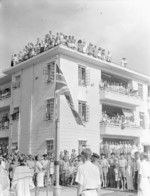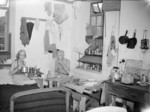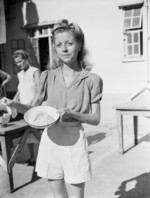Stanley Prison and St Stephen's College
| Type | 249 Prison Camp | |
| Historical Name of Location | Hong Kong | |
| Coordinates | 22.211944000, 114.218889000 |
Contributor: C. Peter Chen
ww2dbaseIn Jan 1937, the Hong Kong Prison at Stanley was established on the Stanley Peninsula in southern Hong Kong. At that time, it was considered the most modern prison across the entire British Empire. Built of stone, concrete, and steel, it was organized into six blocks of cells with the capacity of 1,500 prisoners, and was surrounded by an 18-foot wall. The prison was adjacent to St Stephen's College, which was an educational institution established in May 1929.
ww2dbaseDuring the Battle of Hong Kong, St Stephen's College served in the role of a military hospital. Hours before the official British surrender in Hong Kong on 25 Dec 1941, Japanese troops entered the buildings, pushing aside two doctors, Black and Witney, who confronted them; the two doctors would later be found murdered, their corpses mutilated and dumped on hospital grounds. The troops bayoneted already wounded British, Canadian, and Indian soldiers, and raped a number of the nurses. On 26 Dec 1941, on campus grounds of the school, the Japanese burned over the bodies of over 100 soldiers killed in combat, soldiers murdered in the hospital, and medical personnel murdered in the hospital.
ww2dbaseOn 4 Jan 1942, the Japanese occupations authorities posted an English-language notice in a local newspaper, requiring all all non-Chinese "enemy nationals" to assembly on Murray Parade Grounds, and about 1,000 people complied. Additionally, a number of those who did not comply voluntarily were forcibly taken out of their homes. These people were interned in dirty hotels and brothels on the waterfront near the present-day Macau Ferry Pier for 17 days, and then they were relocated by boat to the Stanley Peninsula, where the Japanese had planned to intern them across the grounds of the prison and the grounds and buildings of St Stephen's College. The Stanley Prison cells would not hold civilian internees; they were reserved by the Japanese to hold criminals. During the occupation period, about 2,800 civilians were held at the internment camp; it was estimated that about 2,500 of them were British (about 60% of whom male; there were 286 children of age 16 or younger). Several hundred of the internees were held at the school, while the majority were held on the prison grounds. Almost all of the school buildings were used to house internees. The prison officers' club was used as a canteen, a kindergarten, Catholic church, and recreation center for the internees. Most of the prison guards' quarters were used to house internees, while a building previously house unmarried Indian prison guards was repurposed as the Tweed Bay Hospital for internees. The former homes of the prison superintendent and the prison doctor were used as the Japanese camp headquarters, the staff of which reported to the Japanese Foreign Affairs Department. The Japanese administration provided less than adequate food for the internee population, but they were allowed to receive food packages, including those from the Red Cross; internees also smuggled in food from the black market. Medical supplies were inadequate, but the high number of medical professionals among the internees most likely made a difference in the low death toll of the camp during its operation. The Japanese allowed the internees to hold musical productions, holiday celebrations, and school lessons. Three escape attempts were made, two of which successful. One of the successful groups made it to Macau, while the other disappeared into the countryside in Guangdong Province, China. The failed escapees were caught shortly after the escape attempt and was eventually re-interned at Stanley. In Jun 1942, 377 American internees were released in exchange for the United States to release a number of Japanese and Thai internees. They were allowed to carry letters written by those they would be leaving behind. These Americans were ultimately brought to Mozambique aboard the passenger ship Asama Maru, and would arrive in New York, New York, United States in Aug 1943. 73 Canadian internees, 13 Latin American internees, and the 24 remaining American internees were released in Sep 1943; they were brought out of Hong Kong aboard the passenger ship Teia Maru for Goa. Internee exchange negotiations took place between Japan and the United Kingdom, but they never reached any agreement.
ww2dbaseThe surviving internees were freed on 16 Aug 1945. Between 1942 and 1945, 121 internees died in the camp, mostly due to illness. 14 the deaths occurred during a US Navy attack against Hong Kong on 16 Jan 1945 when a bomb was aimed at, and hit, Bungalow 5 at St Stephen's College. 7 of the deaths were due to Japanese executions after it was discovered that these men operated a radio transmitter in secret.
ww2dbaseSt Stephen's College was reopened in 1945; in 1950 a chapel was built, and a part of it memorialized those lost during the occupation. The prison, later renamed Stanley Prison, remains in operation in that role at the date of this writing in 2019.
ww2dbaseSource: Wikipedia
Last Major Update: Dec 2019
Stanley Prison and St Stephen's College Interactive Map
Photographs
 |  |  |  |
Stanley Prison and St Stephen's College Timeline
| 23 Dec 1941 | Allied troops in Hong Kong withdrew to the final line, "The Ridge", at the Stanley Peninsula. A military hospital was established at St Stephen's College on the peninsula to treat wounded soldiers. |
| 24 Dec 1941 | Japanese troops penetrated the final Allied defensive line, "The Ridge", at the Stanley Peninsula on Hong Kong island. At St Stephen's College, where an emergency military hospital had been established, 56 wounded soldiers, doctors, and nurses were bayoneted while a number of female civilians were raped. Near the coast, British destroyer HMS Thracian was damaged by Japanese aircraft and was forced to run aground to prevent sinking. |
| 26 Dec 1941 | Japanese troops burned over 100 bodies of soldiers killed in combat, soldiers murdered, and medical personnel murdered over the past several days in and around St Stephen's College in southern Hong Kong; the college had served as a military hospital and one of the final British strongholds. |
| 6 May 1942 | Japanese administration of Stanley Internment Camp in Hong Kong announced that American internees would be repatriated on 15 Jun 1942. Their food rations increased considerably soon after this announcement. |
| 29 Jun 1942 | 377 Americans held at the Stanley Internment Camp in Hong Kong were released in exchange for the United States to release a number of Japanese and Thai internees. |
| 23 Sep 1943 | 73 Canadian internees, 13 Latin American internees, and 24 American internees of Stanley Internment Camp were brought out of Hong Kong aboard passenger ship Teia Maru; they were to be transported to Goa, where an internee exchange with the Allies was to take place. |
| 29 Oct 1943 | Seven internees of the Stanley Internment Camp in Hong Kong were executed by the Japanese administration for their secret possession a radio transmitter. |
| 16 Aug 1945 | The internees of Stanley Internment Camp in Hong Kong were freed. |
Did you enjoy this article or find this article helpful? If so, please consider supporting us on Patreon. Even $1 per month will go a long way! Thank you. Share this article with your friends: Stay updated with WW2DB: |
| WW2-Era Place Name | Hong Kong |
| Lat/Long | 22.2119, 114.2189 |
 |
- » 1,150 biographies
- » 337 events
- » 43,917 timeline entries
- » 1,241 ships
- » 350 aircraft models
- » 207 vehicle models
- » 375 weapon models
- » 123 historical documents
- » 260 facilities
- » 470 book reviews
- » 28,547 photos
- » 432 maps
Captain Henry P. Jim Crowe, Guadalcanal, 13 Jan 1943
Please consider supporting us on Patreon. Even $1 a month will go a long way. Thank you!
Or, please support us by purchasing some WW2DB merchandise at TeeSpring, Thank you!